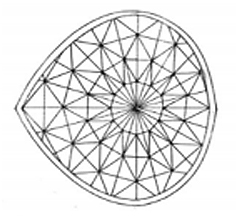Linda Galota
Lo spazio tra le linee interrompe la continuità, genera silenzio ed un profondo senso di vuoto, eppure lascia spazio per tutto il resto. Così i momenti di rottura diventano spazi nella normalità e provocano ripensamenti. Lezioni per vuoti creativi è una raccolta di visioni che nascono nell’imperfezione discontinua dei vuoti dando vita a nuove sensibilità per le nostre future rivoluzioni creative.

Mutare tra i bordi
La lingua giapponese ha fascino. Non è solo un insieme di parole, suoni, caratteri e complessi sistemi di scrittura, ma un intero universo composto da piccoli mondi che, a guardarli bene, riescono a sfiorare ogni segreta interiorità. Così mi è capitato di notare, una volta, nel corso di una peregrinazione di pensiero, non una parola, ma qualcosa di più. Un’espressione che a tentare di tradurla nella nostra lingua inevitabilmente si appiattisce. Chissà perché poi? Forse c’è tutta una poesia ed una profondità che si può sentire solo attraverso gli occhi del cuore.
Mono no aware è letteralmente il pathos (aware) per le cose (mono). È una forma di afflizione dolce e malinconica allo stesso tempo nei confronti dell’effimero. Una sensibilità acuta nell’osservare e sentire il passare e l’infrangersi del tempo che lentamente muta, trasforma e cambia per sempre ogni cosa. Mi sono chiesta se potessi interiorizzare questo concetto, lasciare che abbracciasse ogni angolo e diventasse tutt’uno con una storia umana che è quella che ci ha attraversati e inevitabilmente cambiati.
Scientificamente si parla di crescita post-traumatica. Un termine utilizzato per la prima volta da due psicologi dell’Università del North Carolina di nome Richard Tedeschi e Lawrence Calhoun. Ciò che non ti uccide ti fortifica, giusto? Tedeschi e Calhoun stavano conducendo una ricerca su una serie di individui che avevano vissuto profonde trasformazioni a seguito di una serie di difficoltà abbattutesi sulle loro vite. La ricerca venne pubblicata nel 2004 e da allora emersero centinaia di nuovi studi a supporto di questa evidenza. La crescita post-traumatica non è altro che un’esperienza ed un’espressione di un cambiamento positivo che risulta da una lotta, da una sfida interna e non solo che provoca una profonda crisi nel corso di una vita. È come se la ricerca di Tedeschi e Calhoun (di)mostrasse che una grande luce può sprigionarsi da un grande buio e che una vita può uscirne modificata, mutata. Così la mente, le visioni, le sensibilità, le percezioni ne escono alterate, forse aumentate. Nuovi mondi si schiudono, i veli si strappano, i cuori vengono sommersi e le ricostruzioni diventano possibili.
L’anima si apre a nuove possibilità, a nuovi stimoli e la creatività può prosperare, espandersi, esplorarsi in termini nuovi. Perché è nella creatività e quindi nella creazione di ciò che ancora non c’era che le macerie si trasformano in senso, in significato. E alla fine quel bordo tra la luce e il buio che è la malinconia del monono aware prende colore e ci sprona a giocare tra i confini, i limiti, l’effimero e volare oltre, altrove, in cerca di nuove sensazioni e, forse, afflizioni da contemplare con gioia e nostalgia, in nome di quell’eterno mutare e mutarsi che è lo spettacolo della vita.
Fonte: Tedeschi G. R., Calhoun G. L., Posttraumatic Growth: Conceptual Foundations and Empirical Evidence, Psychological 154, Inquiry, Volume 15, Number 1, 1-18, 2004
